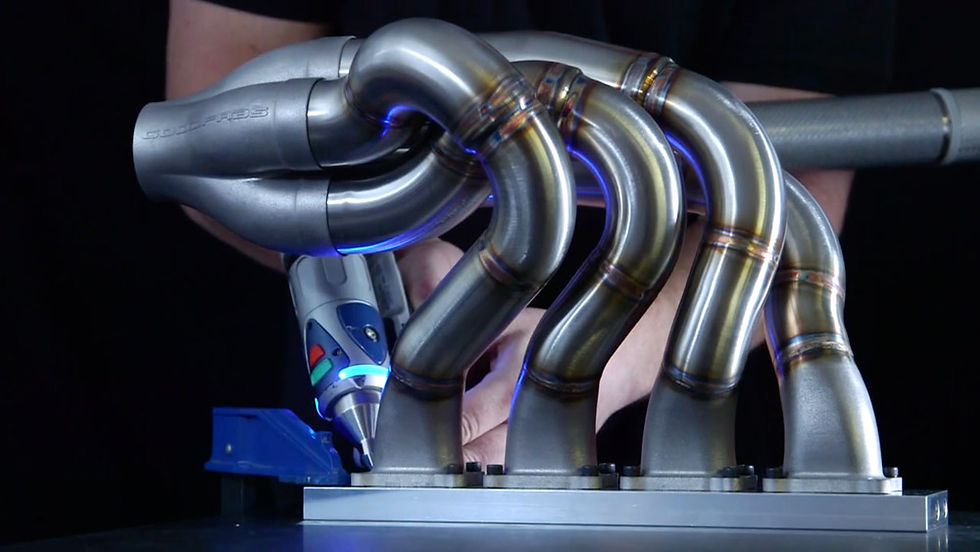Oxygen sensors and engine power
- Good Fabrications Ltd
- Feb 23, 2017
- 4 min read

Oxygen sensor - Lambda sensor
In the automotive and motorsports industry Oxygen sensors (also known as O2 sensors) are often used to monitor the air-fuel ratio in the cylinders and to control the emissions, or increase the performance of the engine. We briefly explain the why, how and what on these sensors?
Exhaust emission control
The oxygen sensors or Lambda sensors are used to make the modern electronic fuel injection and emission control in many internal combustion engines possible. The sensors are generally located in the exhaust pipe.
These oxygen sensors provide real time information to the engine control unit about the air-fuel ratio of the last combustion in the cylinder. By providing the information to this unit, the injection of fuel can be changed to increase the efficiency of the engine and reduce the emissions of hydrocarbons, carbon monoxide and NOx gases (nitrogen oxides) by trying to achieve a stoichiometric air-fuel ratio.
In general there are 2 commonly used oxygen sensors. In the production automotive industry a so called ‘narrowband’ lambda sensor is generally used while in many forms of motorsports a more expensive ‘wideband’ lambda sensor is used.
Narrowband Lambda sensor
The narrowband lambda sensor (or O2 sensor) can only determine three types of mixtures in the exhaust gases. Is the mixture either Rich, Stoichiometric or Lean. It cannot provide information on how rich or how lean the exhaust gas mixture is to the engine control unit (ECU).
When this sensor is used, the ECU reads the signal and decides to either increase or decrease the amount of fuel injected in the cylinder by a set value and do this over and over again to reach the stoichiometric readings.
Since this sensor only provides a limited amount of information, this sensor is not suited to be used in the development of exhaust systems and a wideband O2 sensor could provide a solution.
Wideband Lambda sensor
The wideband oxygen sensor can provide a lot more information about the mixture and can do this in real time.
Opposite to the behaviour of the narrowband lambda sensor, where only rich, stoichiometric or lean signals can be read this sensor is able to provide the exact air-fuel ratio the engine (or cylinder) is currently running at.
Because of the real time information, this sensor is ideal to evaluate development exhaust systems and engine control settings.
How does it work
The narrowband oxygen sensor is generally based on a solid-state electrochemical fuel cell. It consists of two electrodes which provide a certain output voltage depending on the amount of of oxygen in the exhaust system relative to that in the atmosphere.
The sensor creates a DC output voltage between 0.2V and 0.8V where the lower value represents a lean mixture and the higher value represents a rich mixture.
When a voltage of approximately 0.45V is generated the mixture is seen as optimal for emisions which is ~0.5% lean of the stoichiometric ratio of the air-fuel mixture. At this point, the exhaust gases contain a minimal amount of carbon monoxide.
The voltage produced by the sensor is nonlinear with respect to oxygen concentration. The sensor is most sensitive near the stoichiometric point (where λ = 1) and less sensitive when either very lean or very rich.
The wideband oxygen sensor (often known as UEGO sensors) however is also based on a planar zirconia element, but has an incorporated electrochemical gas pump.
This pump is controlled with a closed loop feedback which keeps the output of the electrochemical cell at a constant ratio. Because of this feedback loop, the sensor provides a very accurate real time signal of the air-fuel mixture in the exhaust system.
This sensor operates on a voltage between 0.5V and 4.5V and has a wider signal band where a lower voltage represents a leaner air-fuel ratio and a higher voltage represents a richer air-fuel ratio.

Increasing engine power by changing air-fuel mixture
To increase the engine power it is often said that optimising the air-fuel mixture is one of the key aspects. A properly tuned engine with a calibrated air-fuel ratio is indeed critical for optimal performance and durability of the engine.
The theoretical a stoichiometric air-fuel ratio is the perfect ratio of fuel and air which in a gasoline engine is 14.7:1. This means that 14.7 units of air are needed to perfectly combust 1 part of gasoline fuel. This value is different for every other type of fuel.
When a leaner mixture is used, there is more air than needed present in the combustion chamber which can result in a higher combustion temperature. The opposite happens when there is more fuel than needed in the combustion chamber.
It is known that normally aspirated spark ignition engines produce the most power when the air fuel mixture is just slightly rich of the stoichiometric value of 14.7:1.
Generally this value is kept between 13:1 and 12:1 to keep the exhaust gas temperatures as low as possible without losing power.
When using a turbocharged engine, as Formula 1 currently does, an even richer air-fuel ratio could be needed to reduce the knocking effect in the engine.
Because the turbocharged air entering in the cylinder has an increased density and a denser mixture, the cylinder peak pressure and temperature could be significantly higher than it would be in the normally aspirated spark ignition engine meaning there could be an increased danger of knocking if this is not cooled down by running a richer mixture.



